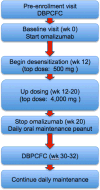A pilot study of omalizumab to facilitate rapid oral desensitization in high-risk peanut-allergic patients
- PMID: 24176117
- PMCID: PMC4405160
- DOI: 10.1016/j.jaci.2013.09.046
A pilot study of omalizumab to facilitate rapid oral desensitization in high-risk peanut-allergic patients
Abstract
Background: Peanut allergy is a major public health problem that affects 1% of the population and has no effective therapy.
Objective: To examine the safety and efficacy of oral desensitization in peanut-allergic children in combination with a brief course of anti-IgE mAb (omalizumab [Xolair]).
Methods: We performed oral peanut desensitization in peanut-allergic children at high risk for developing significant peanut-induced allergic reactions. Omalizumab was administered before and during oral peanut desensitization.
Results: We enrolled 13 children (median age, 10 years), with a median peanut-specific IgE level of 229 kU(A)/L and a median total serum IgE level of 621 kU/L, who failed an initial double-blind placebo-controlled food challenge at peanut flour doses of 100 mg or less. After pretreatment with omalizumab, all 13 subjects tolerated the initial 11 desensitization doses given on the first day, including the maximum dose of 500 mg peanut flour (cumulative dose, 992 mg, equivalent to >2 peanuts), requiring minimal or no rescue therapy. Twelve subjects then reached the maximum maintenance dose of 4000 mg peanut flour per day in a median time of 8 weeks, at which point omalizumab was discontinued. All 12 subjects continued on 4000 mg peanut flour per day and subsequently tolerated a challenge with 8000 mg peanut flour (equivalent to about 20 peanuts), or 160 to 400 times the dose tolerated before desensitization. During the study, 6 of the 13 subjects experienced mild or no allergic reactions, 5 subjects had grade 2 reactions, and 2 subjects had grade 3 reactions, all of which responded rapidly to treatment.
Conclusions: Among children with high-risk peanut allergy, treatment with omalizumab may facilitate rapid oral desensitization and qualitatively improve the desensitization process.
Keywords: DBPCFC; Double-blind, placebo-controlled food challenge; Oral immunotherapy; desensitization; food allergy; omalizumab; peanut allergy.
Copyright © 2013 American Academy of Allergy, Asthma & Immunology. Published by Mosby, Inc. All rights reserved.
References
-
- Sicherer SH, Sampson HA. Food allergy. J Allergy Clin Immunol. 2010;125:S116–25. - PubMed
-
- Lack G. Clinical practice. Food allergy. N Engl J Med. 2008;359:1252–60. - PubMed
-
- Burks AW. Peanut allergy. Lancet. 2008;371:1538–46. - PubMed
-
- Lack G, Fox D, Northstone K, Golding J. Factors associated with the development of peanut allergy in childhood. N Engl J Med. 2003;348:977–85. - PubMed
-
- Sicherer SH, Munoz-Furlong A, Godbold JH, Sampson HA. US prevalence of self-reported peanut, tree nut, and sesame allergy: 11-year follow-up. J Allergy Clin Immunol. 2010;125:1322–6. - PubMed


